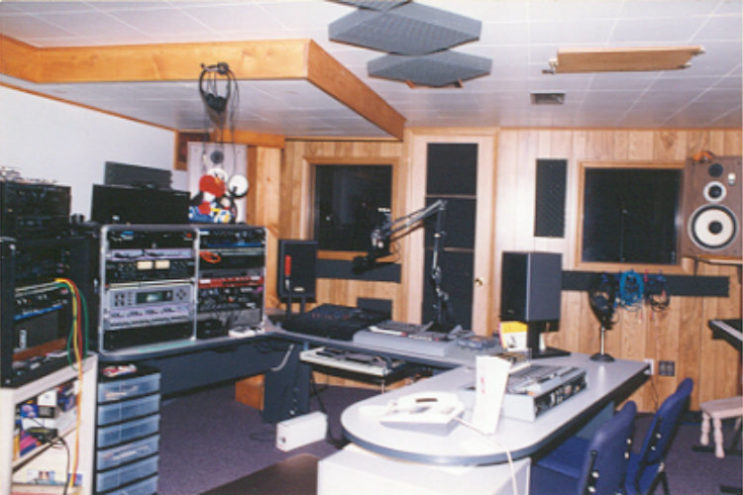Monitoring is one of the most crucial steps in recording and CD production. It is important that we understand both the equipment and the techniques associated with monitoring.
A speaker is not a monitor
Monitors are designed to perfectly recreate what we have recorded, good or bad.
Monitors are designed to be listened to away from walls which will cause us to hear artificially high bass levels. Monitors are designed to be precise so that we can detect noises, phase problems and other recording imperfections. Monitors are designed to sound good only when you are close to them, hence the term near-field monitors.
Speakers on the other hand are designed to make everything we play on them sound good. They are seldom accurate and they usually overemphasize the bottom end. Speakers are designed to sound well from across the room. Also realize that today’s listener likes a thunderous bass, so speaker manufacturers make sure their products give plenty of it. For this same reason, you should never mix using a sub woofer.
Monitors should make music sound like crap, sometimes!
It amazes me at how many producers will go into a music store and upon hearing a set of monitors say something like, “they sound good.” What? They sound good? Based on what comparison do they sound good?
Listen up, unless you know the strong points and weak points of the music you are listening to it is impossible to know if a monitor is good or bad. For instance the original recording might be crap. If the monitors make crap mixes sound good do you really want to own that monitor? Do you really want your monitor to lie to you and tell you your mix is beautiful, only to find out that on the street it sounds bad?
Flat is best, right?
When it comes to choosing a monitor, this is by far the biggest area of confusion. I cannot tell you how many times I have heard a salesman or a customer commenting that a set of monitors really sound flat.
Flat response simply means is that a monitor does not add to, or deduct from the music being put into it. Once again, unless you are 100% certain of what the original frequency curve of the recorded music looked and sounded like, there is no humanly way possible to know if the monitors are flat or not.
It takes years of training for an engineer to be able to hear and recognize the tones represented by different frequencies. However, before you get all bent out of shape worrying about how you will ever be able to tell if a monitor is really flat, let me fill you in on a little secret; virtually all studio monitors are produced to be flat. In all honesty, the “flatness” of a monitor is not as crucial as we are lead to believe.
Tommy’s definition of a great monitor!
“A great monitor produces mixes that sound as good on other systems as they do in your own studio.”
Transparency, to me is much more important than flat response. A transparent monitor is one that doesn’t cover anything up and allows you to hear the crucial details of your mixes. Some of the worst monitors available happen to have absolutely flat response.
Which monitors are the best?
For this discussion I am limiting comparisons to units costing $1000/ pair or less. If you can only afford one pair of monitors, purchase a self-powered 8″ variety. Smaller monitors don’t produce as much bass frequencies and will cause you to put too much bass in your mixes. When played back on the street, your music will be muddy and too bassy.
And example of a problematic monitor is the Behringer 2031 Powered 8″. While the low price and bass produced by this monitor are attractive, it is absolutely one of the worst powered monitors I have ever come across. Like most monitors, when auditioned by itself is sounds great, but put it next to a decent monitor such as the M-Audio Bx8a and you will understand what I mean by transparency. After comparing the two, you will find the Behringer unit to be dull and lifeless.
Trust me; if your monitors are dull, your mixes are going to be dull.
While we are at it you can ad the Roland DS series of powered, digital monitors to the list of monitors you don’t want to buy. These things are inaccurate and add too much coloration.
Which monitors do I like?
The Event BAS 20/20 V2 powered monitor remains the best monitor you can buy for under $1000 per set. The KRK V8, M-Audio Bx8a, Yamaha HS80-M, and Event TS and ASP series 8″ monitors all come in close at second. I am not a huge fan of the Alesis MI series although the new Pro Linear series are a bit more dependable. The Tapco PS8 tends to be little harsh in the midrange but offers some eq options to tame this problem. I would put the Alesis and Tapco monitors in the third place group.
Next time we will talk about monitoring techniques, connections and acoustics.
See you then.
Tommy V






Recommended Video
Memphis Rap Unreleased Video Footage: GNerd, DPKOM & Ryan Buckin, Jookin to Yo Gotti's "Harder"04:57
Memphis Rap [Classics] Koopsta Knicca Rapping Acapella
8Ball Shouts Out MemphisRap.com00:12
Rapper La Chat Hood Homegirl interview